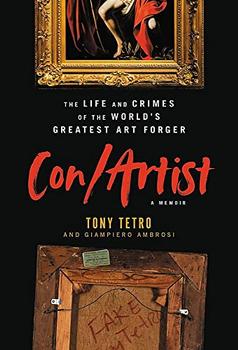Summary | Excerpt | Reviews | Beyond the Book | Readalikes | Genres & Themes | Author Bio

The Life and Crimes of the World's Greatest Art Forger
by Tony Tetro, Giampiero Ambrosi
The curve of First Street where we lived was called Spaghetti Bend. It was the center of what had been the Italian part of Fulton for decades. In the thirties people called Fulton "Little Chicago" because of its reputation for Al Capone–style killings and the fact that it was the mob's stronghold in central New York. When I was growing up, the mob was everywhere, but it was low-key and unremarkable—just part of the atmosphere that you breathed. At the Italian American Club on Broadway, you could see the bosses, Anthony Di Stefano (no relation to my mother) and Bobo Ranieri, playing cards while their entourages hung around, waiting. As far as I knew, they controlled jukeboxes, pinball machines, and the clipboards in every diner and café where you could bet on sports or play the numbers. If you were in trouble, you could borrow money—which everybody told you, "You better pay it back"—but there was no drugs or prostitution or anything seedy that I could see anywhere.
Of course, Fulton did seem to have a lot of failing businesses with paid-up insurance policies and faulty, fire-prone wiring. The Derby Lanes bowling alley, Gayle's Bar and Grill, the car dealership, the furniture store—all of them went up in flames. One of my brother's friends, Lefty Levy, told my brother about torching a few places and even his own car. Lefty had called it "Jewish Lightning." When Bobo Ranieri died, Fulton had a funeral that was talked about for decades, a procession of a hundred black Caddies, as far as the eye could see, coming to pay their respects.
It was impressive, but it didn't do much for me. My heroes weren't mobsters, they were Enzo Ferrari and Leonardo da Vinci—geniuses I could be proud of and aspire to. When I was young, Enzo Ferrari was still in his prime and his cars were absolutely dominant on the racing circuit. They were marvels of engineering, winning every race and overshadowing all the other manufacturers in the world. At the 24 Hours of Le Mans, while other cars flamed out or seized up, the Ferrari cars were so well engineered that they almost never broke down. They became the ambassadors for Italian artistry, breathtaking style, and design excellence, far superior to the bland and simple muscle cars Americans produced. As a child, it made me proud to think of a string of culture from ancient Rome to the Renaissance all the way through to these cars, and that I was in some small way connected to that. Every child constructs a story about where they come from and where they fit in, and I liked this one.
At school, I learned about ancient Rome, and at the time, Hollywood was full of epic films about the majesty and glory of the Eternal City. Ben-Hur had won eleven Academy Awards and filled my mind with panoramic, Technicolor images of opulence and civilization. To think that my ancestors constructed hundred-mile-long aqueducts and that Roman homes had both hot and cold running water when other people lived unwashed in thatched huts impressed me.
I wasn't much of a student, slouching my way to solid Cs because I wasn't interested in most subjects. I was, however, always good at and interested in art. Even at just nine or ten years old I was copying photographs from books or magazines that my mother, an avid reader, would leave lying around the house. I remember once I copied, freehand, a photograph of Steve Reeves, the bodybuilder and actor from the movie Hercules. He was wearing his half toga, holding chains, and pulling down two columns—the pillars of mythical fame. When I finished my drawing, I proudly showed my mother, who praised me, but my oldest brother, Jim, belittled me, accusing me of tracing from the photo. "No! That's not true," I shouted, and then I showed him that my drawing was actually much larger than the photograph. I was deeply offended because I was very proud of my work.
Our town had a beautiful Carnegie library and it was there that the Mickey Mouse Club held its meetings. Every Tuesday night after dinner, we'd troop downstairs with our ears on to sing songs and learn about the practice of good citizenship according to the gospel of Walt Disney. After our meeting, I'd wander over to the art section and leaf through Abrams art books, looking at the pictures.
Excerpted from Con/Artist by Tony Tetro and Giampiero Ambrosi. Copyright © 2022 by Tony Tetro and Giampiero Ambrosi. Excerpted by permission of Hachette Books. All rights reserved. No part of this excerpt may be reproduced or reprinted without permission in writing from the publisher.
Your guide toexceptional books
BookBrowse seeks out and recommends the best in contemporary fiction and nonfiction—books that not only engage and entertain but also deepen our understanding of ourselves and the world around us.